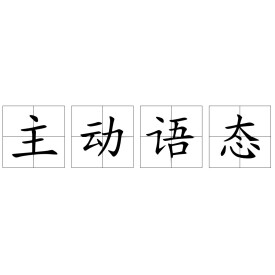主動語態
主語是謂語動作使動方的語態
主動語態是表示主語是謂語動作的使動方的語態。在主動語態中,謂語的動作源自主語,而施加於賓語。
相反,在被動語態中,主語是謂語動作的受動方。
在主動語態中,主語後面接人(be +動詞原型)
被動語態(be+動詞過去分詞)
在主動語態中,主語是謂語動詞的使動方。在被動語態中,主語是謂語動詞的受動方。
在語法結構上,主動語態和被動語態的區別主要在於,主動語態直接使用動詞原形作為謂語,然後再在該動詞原形的基礎上施加時態和其他語法;而被動語態則使用系詞+動詞的過去分詞作為謂語,各種時態和其他語法也施加在系詞上。
舉例:
1.主動語態:The snowslide killed him. 雪崩害死了他。
被動語態:He was killed by the snowslide. 他死於雪崩。
2.主動語態:We use electricity to run machines. 我們用電力來開動機器。
被動語態:Electricity is used to run machines. 電力被我們用來開動機器。
3.主動語態:Bell invented the telephone in 1876.貝爾於1876年發明了電話。
被動語態:The telephone was invented by Bell in1876.電話是貝爾於1876年發明的。
1)wash, clean, cook, iron, look, cut, sell, read, wear, feel, draw, write, sell, drive…
The book sells well. 這本書銷路好。
This knife cuts easily. 這刀子很好用。
2)blame, lent(出租), remain, keep, rent, build
I was to blame for the accident. 我對這起事故負責。
Much work remains. 還有大量工作要做。
3) 在need, require, want, worth (形容詞), deserve后的動名詞必須用主動形式。
The door needs repairing.= The door needs to be repaired. 門需要修了。
This room needs cleaning. 這房間應該打掃一下。
This book is worth reading. 這本書值得一讀。
4) 特殊結構:make sb. heard / understood (使別人能聽見
/理解自己),have sth. done ( 要某人做某事)。
有時被動語態不能轉換為主動語態。這主要有下列幾種情況:
1.中國著名學者周海中先生在1986年發表的《英語語態轉換簡論》(下篇)一文中指出,某些句子結構習慣上只用被動語態,這時就不能轉換為主動語態。例如:
All bodies are made up of atoms.
The old man’s race of life was nearly run.
這種被動結構還有be alleged, be bound up with, be done up, be grown over, be knocked up, be held up, be inclined, be lost on, be obliged to, be posted, be rumored to, be said to, be transported, be wound up等。
2.以代詞it作形式主語的被動句,一般不能轉換為主動句。例如:
It is known that sound is a form of energy.
It is observed that the situation of the country is getting better and better.
3.當被動句的施動者沒有表示出來時,不能轉換為主動句。例如:
Albert Einstein was born in 1879.
Manfred was killed in the Second World War.
如果改成主動句時加上一個施動者(如they, someone等),就會有損原句的意思。
